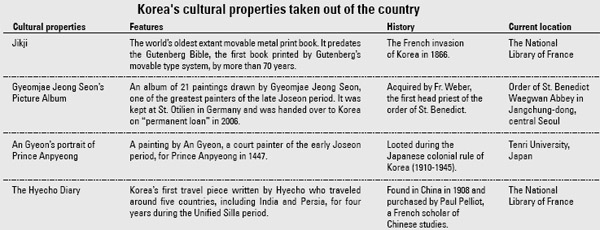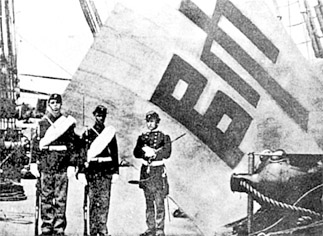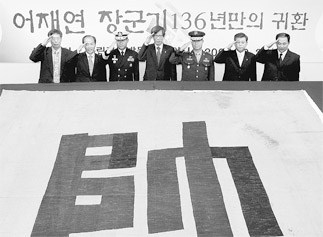What is the ICPRCP and what does it want?

Fortunately, there’s an acronym. But why has the ICPRCP been in the news so much lately?
Last November, the committee marked its 30th anniversary with the so-called Seoul Declaration. It said that all cultural properties that were unlawfully looted by colonial governments during the imperialist era should be returned to their countries of origin.
In particular it drew attention to the case for the return of Uigwe to Korea. These ancient documents, which outline the protocols for royal ceremonies and rituals during the Joseon Dynasty (1392-1910), are currently kept at the National Library of France.
France took these ancient royal documents - 297 volumes in all - from Korea during the French invasion of Korea in 1866.
The Uigwe were originally stored in Oegyujanggak, an annex in the Royal Library, Gyujanggak, on Ganghwa Island, and were for the king’s eyes only.
They are made from high-quality silk and are considered one of Korea’s most precious documentary legacies.
Unesco has categorized Korea as one of the countries that has had many of its cultural properties looted. Other countries include Greece, Egypt, Vietnam and China.
According to the Cultural Heritage Administration of Korea, as of September last year, an estimated 76,143 Korean cultural properties are currently kept in 20 countries around the world.
Of this number, 34,369 are kept in Japan, the highest number in the world, followed by the United States (18,635) and the United Kingdom (6,610).
Most of them were taken out of Korea through various means such as illegal excavation, looting, trade and donations during Korea’s turbulent history.

The banner of Gen. Eo Jae-yeon, known as the Sujagi Flag, was returned home in October 2007, 136 years after it was taken by American soldiers during Sinmiyangyo, the conflict between the U.S. and Korea in 1871.
In 1922, Japan removed the Uigwe relating to the funeral of Queen Min, the last Empress of the Joseon Dynasty, calling the documents a “donation” from the Japanese government of Korea to Japan’s Imperial Household Agency.
The problem is that it is extremely difficult for any country to restore stolen cultural properties to the countries of origin.
Since 1958, when a project calling for the repatriation of Korean relics kept abroad was first launched, Korea has recovered only 7,466 artifacts from 10 countries.
In 2006, Korea recovered from Japan 47 out of 74 volumes of a copy of the Joseon Sillok, loosely translated as “true records,” originally kept in the Mount Odae Archives on Ganghwa.
It took 93 years for Korea to retrieve the historical documents as a “permanent loan.” Japan took them in 1913.

The flag, which had been kept at the Museum of the U.S. Naval Academy in Annapolis, Maryland, has not been returned permanently to Korea, though, due to legal and procedural reasons cited by the U.S. Instead, it is on long-term loan for 10 years and is currently on display at the National Palace Museum of Korea. [JoongAng Ilbo]
It was moved to Japan in 1905 and deposited at the Yasukuni Shrine. It was not until 2005 that the monument was returned to its original location at Gilju, Hamgyeong Province, in North Korea.
But most looted Korean cultural properties have still not been returned to their rightful homes.
One example is Jikji, Korean Buddhist documents dating back to 1377. Kept in France, the documents were recognized as the world’s oldest movable metal print book by Unesco in 2001.
The uigwe of Oegyujanggak in France is another. At a Korea-France summit in Seoul in 1993, French President Francois Mitterrand returned one of the 297 books to then President Kim Young-sam.
Mitterrand promised to return the complete collection, just as France was bidding to export its high-speed TGV train technology to Korea.
The export of the TGV later materialized, but the promise of the returned documents remains unfulfilled.
The reason for France’s reluctance to return the historically significant books to Korea might be because of a concern about precedent.
If the uigwe were returned to Korea, France might receive similar requests from other Asian and African countries whose properties are kept in museums in France, such as the Louvre.
When the National Museum of Korea recently unveiled five Buddhist treasures from the Unified Silla period, there was intense public interest.
The items were on loan from national museums in Japan as part of the “Echoes of Life, the Enduring Tradition of Unified Silla Sculpture” exhibition that runs through March 1. They form part of the Ogura Collection, an extensive and controversial selection of Northeast Asian antiquities collected by Takenoske Ogura, the late Japanese entrepreneur, when he was head of an electronics firm in Korea in the 1930s and ’40s.
The collection, which includes about 1,100 pieces from Korea, is what many historians describe as the largest personal collection of Korean artifacts in the world.
It includes top national treasures like the five Buddhist statues in the current exhibition.
However, the exhibition was carried out under the strict condition that there would be no discussion about whether or not the items in the display should be repatriated, according to the curator.
Of course, it is not possible to stop the general public from discussing the issue but the organizers of the exhibition made it very clear that the items from the Ogura Collection were in Korea on a temporary basis only.
Clearly, many people in Korea feel strongly that historically significant items from the past should be returned here.
But it should be noted that governments around the world cannot easily take items from private collections and have them returned to Korea.
By Park Hyung-soo JoongAng Ilbo/ Park Sun-young Staff Reporter [spark0320@joongang.co.kr]










with the Korea JoongAng Daily
To write comments, please log in to one of the accounts.
Standards Board Policy (0/250자)